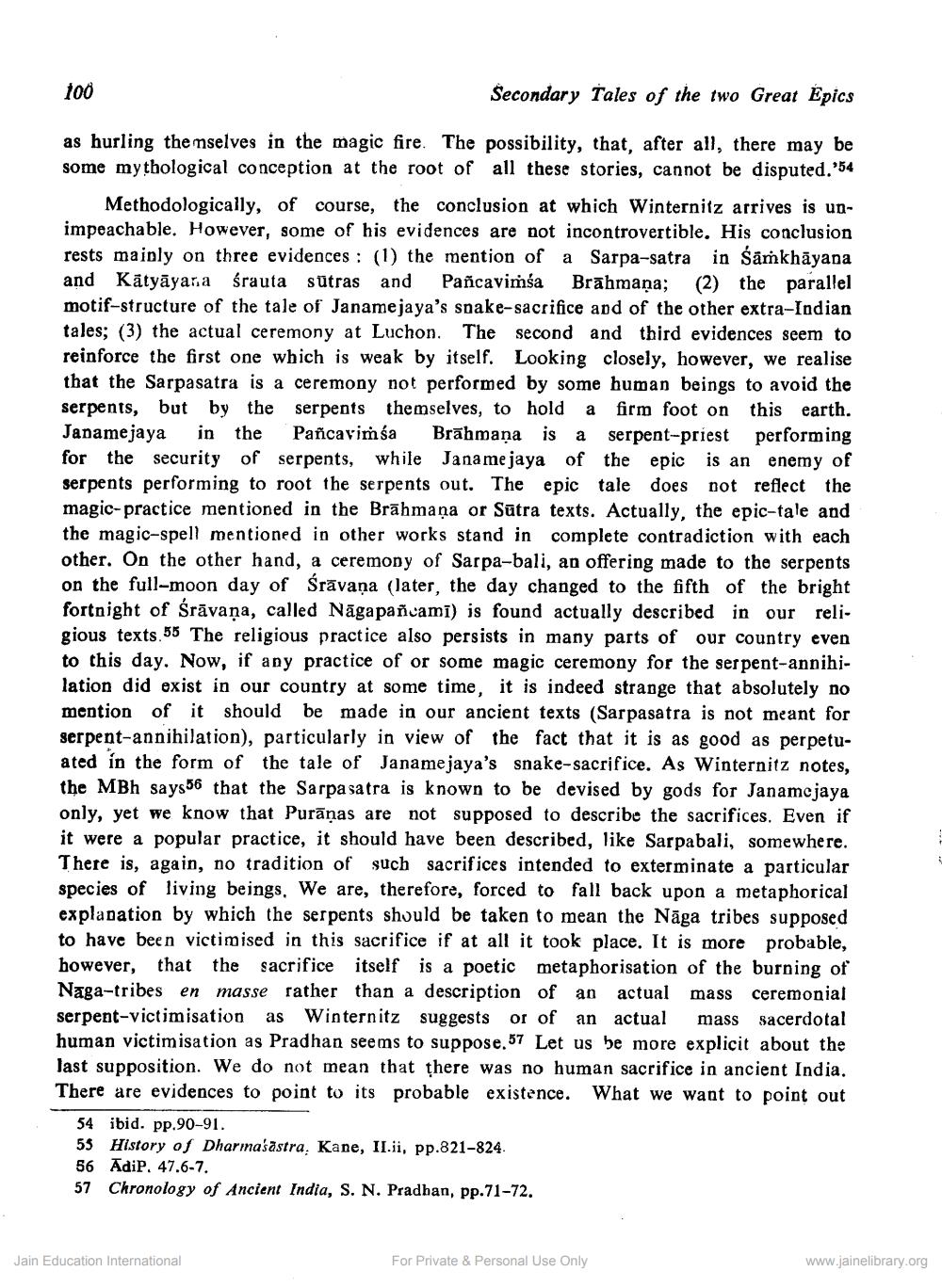________________
100
Secondary Tales of the two Great Epics as hurling themselves in the magic fire. The possibility, that, after all, there may be some mythological conception at the root of all these stories, cannot be disputed."54
Methodologically, of course, the conclusion at which Winternitz arrives is unimpeachable. However, some of his evidences are not incontrovertible. His conclusion rests mainly on three evidences: (1) the mention of a Sarpa-satra in Śamkhāyana and Katyayana śrauta sutras and Pañcavimśa Brahmana; (2) the parallel motif-structure of the tale of Janamejaya's snake-sacrifice and of the other extra-Indian tales; (3) the actual ceremony at Luchon. The second and third evidences seem to reinforce the first one which is weak by itself. Looking closely, however, we realise that the Sarpasatra is a ceremony not performed by some human beings to avoid the serpents, but by the serpents themselves, to hold a firm foot on this earth. Janamejaya in the Pafcavitha Brahmana is a serpent-priest performing for the security of serpents, while Janamejaya of the epic is an enemy of serpents performing to root the serpents out. The epic tale does not reflect the magic-practice mentioned in the Brahmana or Sutra texts. Actually, the epic-tale and the magic-spell mentioned in other works stand in complete contradiction with each other. On the other hand, a ceremony of Sarpa-bali, an offering made to the serpents on the full-moon day of Śravana (later, the day changed to the fifth of the bright fortnight of Śrāvaṇa, called Nagapañcami) is found actually described in our religious texts 55 The religious practice also persists in many parts of our country even to this day. Now, if any practice of or some magic ceremony for the serpent-annihilation did exist in our country at some time, it is indeed strange that absolutely no mention of it should be made in our ancient texts (Sarpasatra is not meant for serpent-annihilation), particularly in view of the fact that it is as good as perpetuated in the form of the tale of Janamejaya's snake-sacrifice. As Winternitz notes, the MBh says that the Sarpasatra is known to be devised by gods for Janamejaya only, yet we know that Puranas are not supposed to describe the sacrifices. Even if it were a popular practice, it should have been described, like Sarpabali, somewhere. There is, again, no tradition of such sacrifices intended to exterminate a particular. species of living beings, We are, therefore, forced to fall back upon a metaphorical explanation by which the serpents should be taken to mean the Näga tribes supposed to have been victimised in this sacrifice if at all it took place. It is more probable, however, that the sacrifice itself is a poetic metaphorisation of the burning of Naga-tribes en masse rather than a description of an actual mass ceremonial serpent-victimisation as Winternitz suggests or of an actual mass sacerdotal human victimisation as Pradhan seems to suppose. 57 Let us be more explicit about the last supposition. We do not mean that there was no human sacrifice in ancient India. There are evidences to point to its probable existence. What we want to point out
54 ibid. pp.90-91.
55 History of Dharmasastra, Kane, II.ii, pp.821-824.
56 AdiP. 47.6-7.
57 Chronology of Ancient India, S. N. Pradhan, pp.71-72.
Jain Education International
For Private & Personal Use Only
www.jainelibrary.org




